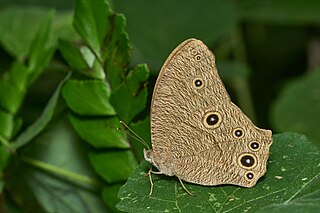
Melanitis leda, the common evening brown, is a common species of butterfly found flying at dusk. The flight of this species is erratic. They are found in Africa, South Asia and South-east Asia extending to parts of Australia.

Lampides boeticus, the pea blue, or long-tailed blue, is a small butterfly that belongs to the lycaenids or gossamer-winged family.

Nomophila noctuella, the rush veneer, is a species of moth of the family Crambidae.

Metoeca is a genus of moths of the family Crambidae. It contains only one species Metoeca foedalis, which has a wide distribution, including the Democratic Republic of Congo, Equatorial Guinea, South Africa, China, Japan, Taiwan, Thailand and Australia (Queensland).

Niphograpta is a genus of moths of the family Crambidae. It contains only one species, the waterhyacinth moth. It is native to the Amazon basin, but has been introduced in North America, Africa and Australia to control the spread of water hyacinth.
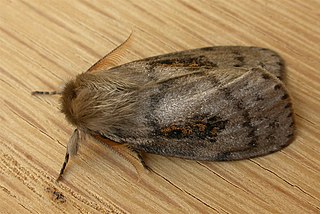
Leptocneria is a genus of moths in the subfamily Lymantriinae erected by Arthur Gardiner Butler in 1886. The wings of the moth are generally dark brown, with some variations containing a medley of dark and light hues.
Cryptophlebia ombrodelta, the litchi fruit moth or macadamia nut borer, is a moth of the family Tortricidae. The species was first described by Oswald Bertram Lower in 1898. It is native to India, Sri Lanka, Nepal, Indonesia, China, Taiwan, Vietnam, Thailand, western Malaysia, New Guinea, the Philippines, Japan, Guam, the Caroline Islands, Australia and has been introduced to Hawaii.

Hepalastis pumilio is a moth of the family Pterophoridae. It has worldwide tropical distribution, including Argentina, Brazil, Colombia, Costa Rica, Cuba, Ecuador, Guadeloupe, Jamaica, Mexico, Puerto Rico, Suriname, Japan, Micronesia, South Africa the Virgin Islands as well as Queensland and New Guinea.
Setomorpha is a monotypic moth genus in the family Tineidae described by Philipp Christoph Zeller in 1852. Its only species, Setomorpha rutella, the tropical tobacco moth, was described by the same author in the same year. It is a widely spread species that has been distributed by commerce over much of the warmer parts of Africa, Eurasia, Malaysia, Australia, many Pacific islands and North and South America.

Hypocysta euphemia, the rock ringlet, is a species of butterfly of the family Nymphalidae. It is found in Australia, including southern Queensland, New South Wales and Victoria.

Hypocysta angustata, the black and white ringlet or pied ringlet, is a species of butterfly of the family Nymphalidae. It is found on the Cape York Peninsula in Australia and in the rainforests of New Guinea.
Curena externalis is a species of snout moth in the genus Curena. It was described by Francis Walker in 1866. It is found in the Australian states of New South Wales and Queensland.
Endosimilis is a monotypic snout moth genus described by Paul Ernest Sutton Whalley in 1961. Its only species, E. stilbealis, was described by Francis Walker in 1859. It is found in Australia.
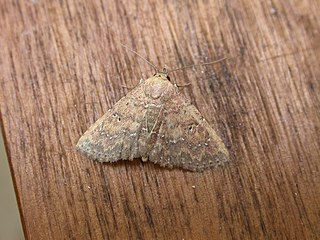
Cerynea trogobasis is a species of moth of the family Erebidae first described by George Hampson in 1910. It is found in Queensland in Australia and the Kai Islands of Indonesia.

Culladia cuneiferellus is a species of the family Crambidae in the genus Culladia. It was described by Francis Walker in 1863. It is found in Australia, New Caledonia, Norfolk Island, the New Hebrides and the Loyalty Islands. It is also present in New Zealand.

Away colours are a choice of coloured clothing used in team sports. They are required to be worn by one team during a game between teams that would otherwise wear the same colours as each other, or similar colours. This change prevents confusion for officials, players, and spectators. In most sports, it is the visiting or road team that must change – second-choice kits are commonly known as away kits or change kits in British English, and road uniforms in American English.
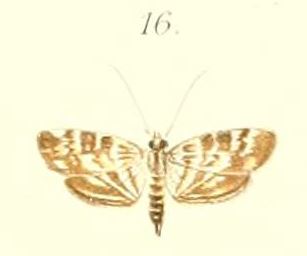
Tabidia insanalis is a moth of the family Crambidae. The species was described by Pieter Cornelius Tobias Snellen in 1879. It is found on Borneo, Sulawesi, Papua New Guinea and Queensland, Australia.

Hyposidra talaca, the black looper or black inch worm, is a moth of the family Geometridae. The species was first described by Francis Walker in 1860. It is found from India to Indochina, Sundaland, Sulawesi, the Philippines, Sri Lanka, the Solomon Islands, Thailand, Taiwan, New Guinea and Australia, where it has been recorded from Queensland. It is a major defoliating pest in tea plantations.

Cureña is a district of the Sarapiquí canton, in the Heredia province of Costa Rica.
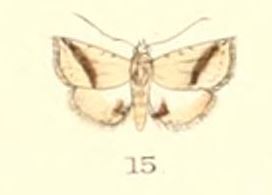
Eublemma pudica is a moth of the family Erebidae first described by Snellen in 1880. It is found in Sri Lanka, India, Fiji and Australia.













